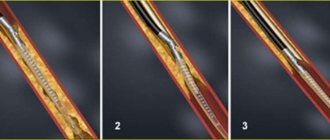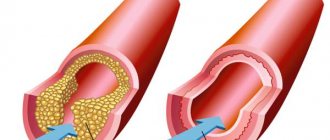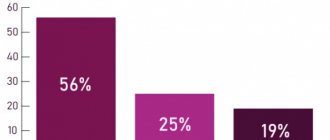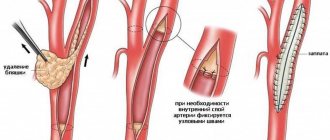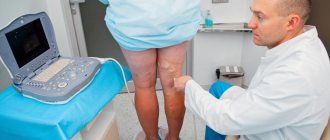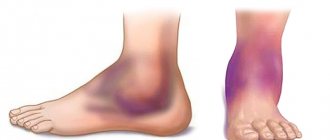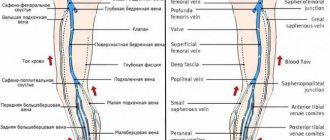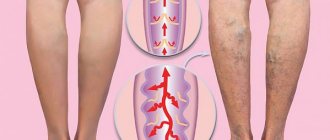Symptoms
With angiospastic syndrome, prolonged spasm of the vessels of the extremities occurs. Such patients react acutely to cold air. There is a feeling of coldness in the upper and lower extremities, the color of the skin changes, and numbness is felt. Spasm of the blood vessels in the hand leads to tremor. People with angiospastic syndrome take longer to warm up. Sometimes, with prolonged exposure to low temperatures, atrophic processes develop.
Obliterating atherosclerosis occurs due to thickening of the walls of blood vessels due to fat deposition. Atherosclerotic plaques form, narrowing of the lumen of blood vessels occurs, up to their blocking in certain areas. This does not allow blood to enter the tissues, they do not receive the necessary nutrients.
Symptoms of arterial insufficiency:
- pain in the legs that occurs when walking, which goes away after rest;
- the pain has a constraining, squeezing character;
- limitation of leg mobility;
- thickening of nails;
- hair loss or slow hair growth;
- feeling of coldness, tingling, numbness in the legs;
- ulcerative lesions on the skin;
- lameness.
With spasm of the blood vessels in the legs, the pain is localized in the lower part of the limbs, in the calves. When large blood vessels are blocked, discomfort occurs in the thighs and buttocks. It becomes difficult for patients to walk, run, or climb stairs. With atherosclerosis in the later stages, even painkillers do not help patients cope with pain.
With obliterating endarteritis, damage to small vessels occurs. This occurs due to autoimmune processes and leads to the proliferation of connective tissue. The disease develops quickly. The main symptoms of vascular spasm in the legs during endarteritis:
- leg fatigue;
- lameness;
- sensation of burning and coldness in the fingers of the lower extremities;
- increased sensitivity, pallor or cyanosis of the skin;
- convulsions;
- deterioration of hair and nail growth;
- ulcerative lesions.
With the onset of obliterating endarteritis, patients notice an increase in symptoms after walking a distance of about 200 meters. Over time, this figure decreases; it is difficult for a person to walk more than 60 meters.
If you have diabetes, there is a risk of vascular damage to the upper and lower extremities (microangiopathy). As a result, ischemia occurs, that is, oxygen starvation of tissues.
Characteristics of the disease and features of its development
The development of atherosclerosis of the lower extremities is associated with the presence of pathologies and bad habits in a person, which negatively affect blood counts and the possibility of its movement through the vessels.
This disease can be characterized as damage to the large arteries of the lower extremities, associated with the formation of atherosclerotic plaques on the internal surfaces of their walls. Such deposits slow down blood flow in the legs, as they partially or completely block the lumen of the blood vessels.
The most commonly affected arteries are:
- femoral;
- anterior tibial;
- posterior tibial;
- popliteal;
- common iliacs.
The formed plaque does not remain stable: if provoking factors are not excluded, its size increases to the point that the formation completely clogs the blood vessel.
The development of pathology occurs gradually. The following stages of the pathological process are distinguished:
- Formation of lipid stains. The walls of arteries locally absorb lipid compounds. Externally, the areas that were saturated with them look like light yellow stripes. At this stage, there are no visible disturbances in blood flow, so the disease does not manifest itself in any symptoms.
- Formation of fibrous plaque (atheroma). Areas of lipid stains become inflamed due to the immune system's reaction to the changes occurring. As a result, the fats accumulated in the vessel wall disintegrate, and connective tissue begins to grow in their place. This process is called sclerosis. The forming plaque protrudes into the lumen, preventing the full passage of blood in this area.
- Formation of complicated atheroma. This is the most severe stage, during which pathological changes occur: the cholesterol plaque gradually disintegrates, and its contents (fat molecules and cells surrounded by connective tissue) penetrate into the bloodstream. Erosion appears at the site of the destroyed plaque. Platelets and other elements responsible for blood clotting are concentrated here. This starts the process of accelerated thrombus formation. The affected area in the structure of the vessel grows and thickens, which significantly impedes blood circulation.
The development of this disease is a long process: 10-15 years pass from the appearance of the first changes to the appearance of the initial symptoms. This makes it difficult to start treatment in a timely manner.
Diagnostics
If complaints arise about spasms of blood vessels in the arms and legs, diagnosis begins with a visual examination. The doctor pays attention to the appearance of the skin, its color and condition. Next, he performs manipulations with flexion and extension of the limbs so that the patient reports the degree of pain.
Special diagnostic methods are used:
- oscillography (determination of pressure in blood vessels);
- measuring temperature in various parts of the limbs;
- rheography (determining changes in tissue resistance);
- radioisotope study (determining the filling of blood vessels);
- capillary study;
- angiography (detection of the degree of narrowing of the vessel and the size of the affected area);
- Ultrasound duplex scanning.
Folk remedies
In case of impaired blood circulation in the legs, traditional medicine can provide good help.
All of them are completely safe, accessible and healthy.
Here are some of the most popular proven recipes:
- Place fresh or dried nettles in a bowl, filling 1/3 of the volume. Top up with boiling water. Wait until it cools down to the point where you can put your feet in it. Keep them in the infusion for about 10 minutes. Repeat the procedure after 2 – 3 days.
- Take 300 g of prunes and hazelnuts, half a kilo of raisins and 600 g of walnuts. Pass all this through a meat grinder, add two tablespoons of honey and mix. You need to take the medicine daily, a tablespoon half an hour before each meal (3 times).
- An excellent remedy for poor blood circulation is an infusion of horse chestnut flowers. For a half-liter bottle of vodka, take 50 g of dried flowers and leave in a warm place for two weeks in a dark place. Be sure to shake every day. Take the infusion 30 drops, diluted in a quarter glass of warm water, three times a day before meals (half an hour). Treatment is carried out in courses of 10 days followed by a 5-day break.
- Steaming your feet in a bath with the addition of spruce needles and salt gives a quick effect. You need to add two tablespoons of raw materials per liter of water. And baths with linden blossom will relieve swelling.
The listed methods will help prevent circulatory disorders and improve it. But be sure to see a doctor, as self-medication can lead to undesirable consequences.
Treatment
Treatment of vascular spasms of the extremities directly depends on the stage of the vascular disease. With initial symptoms, you must immediately give up bad habits and reconsider your diet. At the stage of conservative treatment, medications and physiotherapy (metered walking, physical therapy, lymphatic drainage) are used. The main medications for vascular spasms in the legs: sulfonamides, analgesics, glucocorticosteroids.
The goal of treatment is to remove spasm of blood vessels in the legs and arms, reduce blood viscosity, and protect the artery walls from damage. For this, a complex of blockades and antihistamines are used.
The course of treatment is carried out several times a year, some drugs must be taken on an ongoing basis.
In case of large areas of damage, surgical methods are used:
- installation of an alloprosthesis (replacement of part of a blocked vessel);
- shunting (redirecting blood flow around the damaged area);
- removal of atherosclerotic plaque.
In rare cases, with the development of gangrene and necrosis, the limb is amputated.
Features of drug treatment: recommended drugs and ointments
If you have atherosclerosis of the vessels of the lower extremities, you should contact an angiologist. The course of therapy depends on the stage at which the disease was detected.
Conservative treatment is indicated for atherosclerosis of the first and second stages. Patients are prescribed the following drugs:
- Myotropic antispasmodics. Their main effect is to eliminate vasospasm. Patients are prescribed medications Papaverine and No-shpa.
- ACE inhibitors. The purpose of these drugs is to normalize blood pressure and reduce the risk of complications from the cardiovascular system. This group includes Enalapril, Captopril, Ramipril.
- Statins. These are drugs whose action is aimed at reducing the activity of enzymes responsible for the production of cholesterol. Statins also increase the elasticity of artery walls and reduce the ability of platelets to aggregate. These drugs include Simvastatin and Atorvastatin.
- Medicines of the nicotinic acid group. Their properties include normalizing the lipid composition of the blood, stimulating the process of fat breakdown and metabolic processes in general, and reducing the load on the heart muscle. A representative of this group of drugs is Nicotinic acid in the form of an injection solution.
- Disaggregants. Such drugs improve the rheological properties of blood. This group includes the drugs Clopidogrel, Aspirin, Tiklid.
- Thrombolytics (fibrinolytics). Such medications act on a blood clot that has formed in the artery, dissolving it. This improves blood flow. Names of drugs – Streptokinase, Prourokinase, Retaplase.
When treating atherosclerosis, patients take vitamins in tablet form. Vitamins that are useful for this disease are:
- A;
- Group B (B1, B2, B3, B6, B12, B15);
- WITH;
- D;
- E.
Dietary supplements are also useful. These are not medications, but food supplements that contain useful substances and microelements. Patients with atherosclerosis need antioxidants (lecithin) and microelements (calcium, selenium, magnesium).
In addition to tablets, patients are recommended to use topical preparations (gels and ointments) with anti-inflammatory and analgesic effects. The most commonly used medications are Diclofenac (1%) and Nimid.
Prevention
To prevent spasms of blood vessels in the extremities (arms and legs), it is necessary to eliminate risk factors as much as possible:
- Adhere to a healthy lifestyle (balance your diet, quit bad habits, exercise).
- Monitor your own weight and general health.
- People over 40 years of age should monitor blood glucose and cholesterol levels, as well as blood pressure.
- If your heredity is aggravated by diseases such as diabetes, heart attack, stroke, do screening at least 4 times a year.
- Avoid hypothermia and injury.
General Tips
All the methods described below are best used in combination, since individually they will not give a pronounced effect:
- Control your weight . With excess body weight, the load on the legs increases, the blood vessels deteriorate and blood circulation is impaired. If possible, try to get rid of extra pounds.
- Visit your doctor . Poor circulation is only a consequence of more serious diseases. A comprehensive examination will help identify varicose veins, diabetes, heart problems, osteochondrosis, abnormalities in the composition of the blood or disorders of the autonomic nervous system. Start treatment by eliminating diseases.
- Buy special tights with a massage effect at the pharmacy . They will help reduce the load on your legs and help restore blood circulation.
- After consulting with your doctor first, start taking preventive medications such as Venza, Ascorutin, Escusan, and so on.
- Every evening after taking a bath or shower, perform a light, rubbing foot massage using ointments with medicinal ingredients.
- Improve the general condition of the body . Be sure to take a complete vitamin complex every quarter.
- Avoid uncomfortable shoes . If it is tight, narrow or in high heels, then blood stagnation occurs in the legs and its circulation is impaired. Give preference to soft shoes made of natural, breathable materials with small wedges.
- Don't wear tight clothes . Jeans or trousers that are too tight compress the blood vessels, making normal circulation impossible.
- Use a contrast shower daily . This will relieve tension and improve blood circulation.
- Learn to sit correctly . Do not cross your legs; change the position of your legs from time to time. Sitting and standing for too long also leads to poor circulation, so alternate between them.
- Visit a good reflexologist . Massaging certain points on the feet improves blood flow, relieves fatigue and has a beneficial effect on improving immunity.
Popular questions about vascular spasms of the extremities
What causes spasms?
The cause of vascular spasms in the extremities is a number of diseases such as angiospastic syndrome, obliterating atherosclerosis and endarteritis, diabetes mellitus. Also, spasms of the blood vessels of the arms and legs occur as a reaction to prolonged exposure to cold, nicotine intoxication or frostbite.
How long to treat vascular spasms of the extremities?
Some medications for spasms of blood vessels are recommended for use throughout life, others - as part of a therapeutic course, which depends on the degree of the disease.
Which doctor treats vascular spasms?
After identifying symptoms associated with vascular spasms of the extremities, you must consult an angiologist or phlebologist.
Advantages of visiting the Medical Center for Endovascular Surgery
If you or your loved ones are faced with atherosclerosis of the lower extremities, we recommend contacting the Professor Kapranov Medical Center. This institution employs only experienced specialists - doctors of the highest category, candidates and doctors of science.
Before starting therapy, the patient undergoes a comprehensive examination: this approach will allow one to accurately determine the degree of development of the pathology and select the most appropriate treatment method.
By contacting our Center, you can:
- consult with leading experts;
- undergo a full diagnostic examination;
- cope with vascular disease by performing modern operations that guarantee results and patient safety.
If you are planning to contact the Medical Center for Endovascular Surgery and would like to receive more information about our capabilities, call the number provided for a free consultation.

